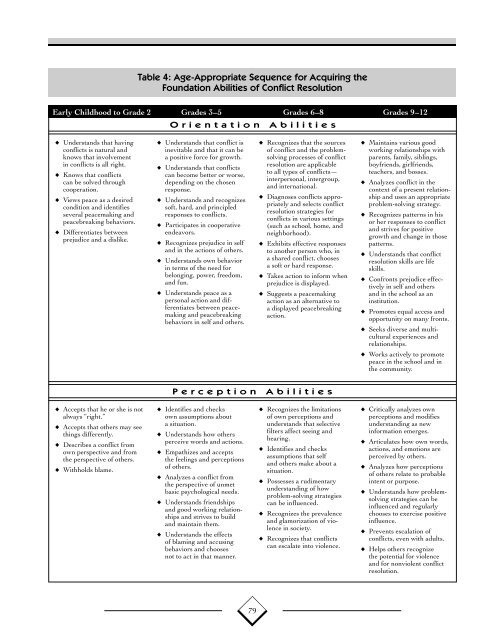Conflict Resolution Education - National Criminal Justice Reference ...
Conflict Resolution Education - National Criminal Justice Reference ...
Conflict Resolution Education - National Criminal Justice Reference ...
Create successful ePaper yourself
Turn your PDF publications into a flip-book with our unique Google optimized e-Paper software.
Early Childhood to Grade 2 Grades 3–5 Grades 6–8 Grades 9–12<br />
O r i e n t a t i o n A b i l i t i e s<br />
♦ Understands that having<br />
conflicts is natural and<br />
knows that involvement<br />
in conflicts is all right.<br />
♦ Knows that conflicts<br />
can be solved through<br />
cooperation.<br />
♦ Views peace as a desired<br />
condition and identifies<br />
several peacemaking and<br />
peacebreaking behaviors.<br />
♦ Differentiates between<br />
prejudice and a dislike.<br />
♦ Accepts that he or she is not<br />
always “right.”<br />
♦ Accepts that others may see<br />
things differently.<br />
♦ Describes a conflict from<br />
own perspective and from<br />
the perspective of others.<br />
♦ Withholds blame.<br />
Table 4: Age-Appropriate Sequence for Acquiring the<br />
Foundation Abilities of <strong>Conflict</strong> <strong>Resolution</strong><br />
♦ Understands that conflict is<br />
inevitable and that it can be<br />
a positive force for growth.<br />
♦ Understands that conflicts<br />
can become better or worse,<br />
depending on the chosen<br />
response.<br />
♦ Understands and recognizes<br />
soft, hard, and principled<br />
responses to conflicts.<br />
♦ Participates in cooperative<br />
endeavors.<br />
♦ Recognizes prejudice in self<br />
and in the actions of others.<br />
♦ Understands own behavior<br />
in terms of the need for<br />
belonging, power, freedom,<br />
and fun.<br />
♦ Understands peace as a<br />
personal action and differentiates<br />
between peacemaking<br />
and peacebreaking<br />
behaviors in self and others.<br />
79<br />
♦ Recognizes that the sources<br />
of conflict and the problemsolving<br />
processes of conflict<br />
resolution are applicable<br />
to all types of conflicts—<br />
interpersonal, intergroup,<br />
and international.<br />
♦ Diagnoses conflicts appropriately<br />
and selects conflict<br />
resolution strategies for<br />
conflicts in various settings<br />
(such as school, home, and<br />
neighborhood).<br />
♦ Exhibits effective responses<br />
to another person who, in<br />
a shared conflict, chooses<br />
a soft or hard response.<br />
♦ Takes action to inform when<br />
prejudice is displayed.<br />
♦ Suggests a peacemaking<br />
action as an alternative to<br />
a displayed peacebreaking<br />
action.<br />
P e r c e p t i o n A b i l i t i e s<br />
♦ Identifies and checks<br />
own assumptions about<br />
a situation.<br />
♦ Understands how others<br />
perceive words and actions.<br />
♦ Empathizes and accepts<br />
the feelings and perceptions<br />
of others.<br />
♦ Analyzes a conflict from<br />
the perspective of unmet<br />
basic psychological needs.<br />
♦ Understands friendships<br />
and good working relationships<br />
and strives to build<br />
and maintain them.<br />
♦ Understands the effects<br />
of blaming and accusing<br />
behaviors and chooses<br />
not to act in that manner.<br />
♦ Recognizes the limitations<br />
of own perceptions and<br />
understands that selective<br />
filters affect seeing and<br />
hearing.<br />
♦ Identifies and checks<br />
assumptions that self<br />
and others make about a<br />
situation.<br />
♦ Possesses a rudimentary<br />
understanding of how<br />
problem-solving strategies<br />
can be influenced.<br />
♦ Recognizes the prevalence<br />
and glamorization of violence<br />
in society.<br />
♦ Recognizes that conflicts<br />
can escalate into violence.<br />
♦ Maintains various good<br />
working relationships with<br />
parents, family, siblings,<br />
boyfriends, girlfriends,<br />
teachers, and bosses.<br />
♦ Analyzes conflict in the<br />
context of a present relationship<br />
and uses an appropriate<br />
problem-solving strategy.<br />
♦ Recognizes patterns in his<br />
or her responses to conflict<br />
and strives for positive<br />
growth and change in those<br />
patterns.<br />
♦ Understands that conflict<br />
resolution skills are life<br />
skills.<br />
♦ Confronts prejudice effectively<br />
in self and others<br />
and in the school as an<br />
institution.<br />
♦ Promotes equal access and<br />
opportunity on many fronts.<br />
♦ Seeks diverse and multicultural<br />
experiences and<br />
relationships.<br />
♦ Works actively to promote<br />
peace in the school and in<br />
the community.<br />
♦ Critically analyzes own<br />
perceptions and modifies<br />
understanding as new<br />
information emerges.<br />
♦ Articulates how own words,<br />
actions, and emotions are<br />
perceived by others.<br />
♦ Analyzes how perceptions<br />
of others relate to probable<br />
intent or purpose.<br />
♦ Understands how problemsolving<br />
strategies can be<br />
influenced and regularly<br />
chooses to exercise positive<br />
influence.<br />
♦ Prevents escalation of<br />
conflicts, even with adults.<br />
♦ Helps others recognize<br />
the potential for violence<br />
and for nonviolent conflict<br />
resolution.

















